"Are you trying to be funny, Yianni?" I asked the chef at MAICh when he presented koliva for dessert recently.
"Yes," he replied.
Most likely, you won't have had it in such an environment. Koliva are associated with death. In the Greek version of this dish, boiled wheat and nuts are shaped into a firm 'cake' which is covered in icing sugar, decorated in almonds and dragees (silver sugar balls) and 'cut' (more like smashed up) at the end of a memorial service for a dearly departed, as dictated by tradition in the Greek Orthodox (and other Christian Orthodox) church. It's very rare to see koliva served elsewhere aside from outside churches and at memorial services, hence my confused horror. While I was trying to enjoy my serving of koliva - it's also very hard to use the two words 'enjoy' and 'koliva' in collocation - it suddenly occurred to me that I had never made koliva myself, even though both my parents have died, which means that I have had a number of opportunities to eat koliva made for my very own dearly departed. These days, businesses specialising in the making of koliva deliver them to the church for you, which is how the koliva part of my parents' memorial services had been handled.
Nowadays, no-soaking-required, quick-boiling wheat is readily available, simplifying the work of the cook. Once the wheat is boiled till soft enough to chew easily (I let it cook for 45 minutes), it is strained and allowed to dry between two towels overnight. I placed the towels in the fridge to insure against spoilage.
Although koliva have been known to Greek people since antiquity, and are made right throughout the year by confectioners specialised in the job, koliva recipes use three ingredients that generally don't get used much in the Greek kitchen: hulled whole wheat grain, toasted crushed sesame seeds and toasted chickpeas ground to a flour.
Although not generally eaten as a sweet outside the demands of tradition, Greek koliva make a delicious dessert. I've even heard of them being served with ice-cream! They are just sweet enough to be enjoyed as a snack any time of the day, and their composition make them the perfect breakfast cereal. Koliva contain everything that regular boxed breakfast cereal contains: whole grains (in this case wheat), and fruit in the form of dried nuts and raisins. But unlike koliva, breakfast cereals have an unacceptable sodium content. It's common knowledge that boxed cereals aimed at children contain both sugar and salt in plentiful supplies, something that even breakfast cereal companies admit themselves. Although koliva are initially made without any sugar added, they are always served with sugar, since the icing sugar that coats them is mixed into the koliva when the 'cake' is shared out after the memorial service. Sugar content can be regulated, as the amount of sugar added to koliva depends on the maker. They taste just as good without any added sugar, since there is a high composition of dried fruit in koliva. When sugar (which creates moisture) is added too soon to koliva, they turn out sludgy. Some people prefer them this way, while others prefer them drier. The drier they are, the slower the fermentation process.
The pomegranate seeds and the blanched almonds were still moist when I mixed the other ingredients, so I let them dry in the fridge overnight before I added them the next day to the nuts-and-flour mixture.
Koliva are always eaten sweetened after a church service since they are always covered in fine icing sugar. At home, I had the chance to have mine without any sugar at all, but it was hard to convince the kids to do the same!
Given that there is no real reason to make koliva in our house, I had to think of a way to get my family to consume them once I made them. I called them 'breakfast cereal', and added chocolate drops to make them more palatable, just like Yianni did at MAICh. They turned out to be very successful. I gave myself the chance to have a go at preparing koliva, at the same time as overcoming my fear of making this special dish which invokes feelings of ethnicity for all Greeks. This cereal dish constituted our daily breakfasts for the first week of this year, a time when grains were traditionally cooked in Crete in the past as a way of welcoming prosperity in the household.
It is customary, when making koliva for loved ones departed to add a few drops or a pinch of an ingredient that the deceased was paticularly partial to, something like their favorite food, eg olive oil, coffee grounds, etc, to personalise the koliva. This was the only part of the ritual that I did not perform, for obvious reasons.
Here are the three recipes that I based my own version on: a koliva recipe by 3A company, one of the firms that packages wheat grains; the breakfast of our ancestors by Peftasteri; and food for the dead by Mariana Kavroulaki (only this one is in English). They all generally use the same technique and ingredients to make koliva.
©All Rights Reserved/Organically cooked. No part of this blog may be reproduced and/or copied by any means without prior consent from Maria Verivaki.

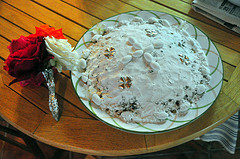
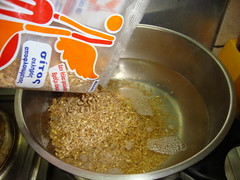
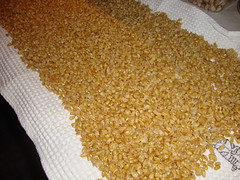
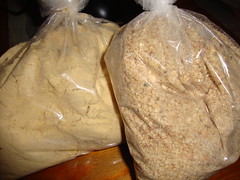
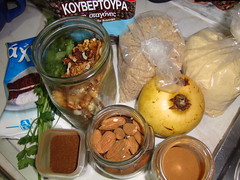
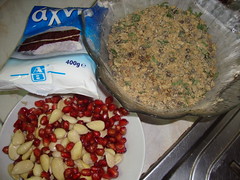
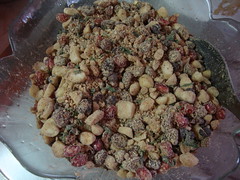
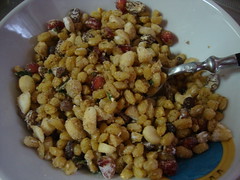
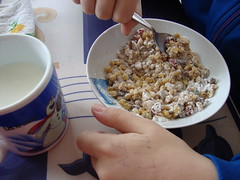
Αχ Μαρία και μου έλεγε η Χαρά να βάλουμε κόλυβα στο μπλογκ και της έλεγα άστο καλύτερα:) ΧΑΧΑ! Μας αρέσουν πολύ και στις δυο γι αυτό! Τέλεια φαίνονται!
ReplyDeleteGood post on this treat that many enjoy. I weirdly anticipate the arrival of Kolyva that my mom will bring back from Saturday of the Souls from church!
ReplyDeleteΤα κόλυβα πάντα τα συνδέω με θάνατο γι' αυτό και μου είναι δύσκολο να τα δω ως γλυκό ή πρωινό Μαρία. Πάντως είναι όντως υγιεινά και σαφώς θρεπτικότερα από οποιοδήποτε κοινό κουτί δημητριακών του εμπορίου.
ReplyDeleteGod might strike me down with a lightening bolt for saying this but Koliva is a major reason I go to church :-)
ReplyDeleteΌπως σου έχω ξαναπεί, λατρεύω τα κόλυβα! Τόσο πολύ, που διάβασα όοοοοολο το ποστ! χαχα! Το θέμα της δηλητηρίασης, το είχαμε πάντα, ειδικά το καλοκαίρι όπως λες κι εσύ. Η συμβουλή που σου έδωσε η κοπέλα στο σουπερ μάρκετ, τη βρίσκω έξυπνη. Σίγουρα η αναμιξη όλων των υλικών βοηθάει στο να χαλάσουν πιο γρήγορα και η υγρασία επίσης. Κι εγώ δενμ έχω κάνει πολλες φορές κόλυβα, αλλά τώρα που μου τα θύμισες, νομίζω πως θα ξανακάνω! Α! Και εννοείται ότι τα τρώω με ζάχαρη! ;-)
ReplyDeleteMy father just flew out this afternoon on his way to my Pappou's memorial service, I think it will be on the ninth, not sure which church. I suppose he'll be having some kolyva - I still never have.
ReplyDeleteThey get a bad rap for obvious reasons and I too have never had them under any other circumstances than to honor the memory of a loved one ... but they do taste good!
ReplyDeleteKoliva is always delicious- and what a nice idea to have some without a memorial/funeral involved. I've watched my in-laws make it a few times. My pethera also saves some liquid after boiling the wheat to use as a facial mask, saying it's great for the skin but I haven't tried it.
ReplyDeleteThanks for sharing. I really enjoy your blog very much. I love finding new recipes.
ReplyDeleteFeel free to check out my recipes also I’m sure you will enjoy.
Weird confession: I actually like the taste of koliva...it's the nuttiness that I enjoy combined with the remaining ingredients. I like that you have experimented with the ingredient itself and tried to remove it from it's association of "mnimosina". I'm just thinking of my mothers reaction if I told her I was going to cook it: she'd be horrified! LOL! Great post Maria-you always make me think!
ReplyDeleteI like the way you got around the symbolism so you could try out the recipe. How fantastic to find someone so helpful and knowledgeable in the supermarket.
ReplyDeleteVery interesting! The variety of foods across the world never ceases to amaze me. I LOVE FOOD!!
ReplyDeleteπρος την Κική:
ReplyDeleteΑγαπητή μου μπορώ να σε ενημερώσω για τα κόλυβα, πότε και γιατί δηλητηριάζουν. Όταν έρθει σε επαφή το σητάρι με τη ζάχαρη, δημιουργείται ζύμωση, και με τη ζύμωση αυτή παράγεται το δηλητήριο. Γι αυτό όταν φτιάχνουν δίσκο για μνημόσυνο, πρέπει να τοποθετήσουν πρώτα το βρασμένο σιτάρι το οποίο το έχεις ανακατέψει καλά με καβουρτισμένο αλεύρι, μετά βάζουμε πατούδα καβουρτισμένη(ρεβύθια αλεσμένα)και μετά πάνω πάνω βάζουμε τη άχνη ζάχαρι. αν θέλετε περισσότερες πληροφορίες το amail μου είναι daskalogianis12@gmail.com
ευχαριστω για την εξηγηση - ετσι μου το ειχαν εξηγησει για την πατουδα - μηπως ξερετε που αλλου χρησιμοποιητε αυτο το υλικο, εκτος απο τα κολυβα???
ReplyDelete